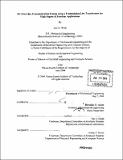| dc.contributor.advisor | Haruhiko H. Asada. | en_US |
| dc.contributor.author | Wade, Eric R. (Eric Randolph), 1978- | en_US |
| dc.contributor.other | Massachusetts Institute of Technology. Dept. of Electrical Engineering and Computer Science. | en_US |
| dc.date.accessioned | 2008-02-28T16:01:39Z | |
| dc.date.available | 2008-02-28T16:01:39Z | |
| dc.date.copyright | 2004 | en_US |
| dc.date.issued | 2004 | en_US |
| dc.identifier.uri | http://hdl.handle.net/1721.1/27144 | |
| dc.description | Thesis (S.M.)--Massachusetts Institute of Technology, Dept. of Mechanical Engineering; and, (S.M.)--Massachusetts Institute of Technology, Dept. of Electrical Engineering and Computer Science, 2004. | en_US |
| dc.description | Includes bibliographical references (leaf 51). | en_US |
| dc.description.abstract | A new type of powerline communication is developed to reduce cable requirements for robotic, electromechanical, and vehicular systems. A DC power bus line connecting a DC power supply to motor drives and sensor units is used for transmitting both data and DC power. Unlike conventional AC powerline communication, the DC power bus provides amenable and predictable noise characteristics and desirable impedance characteristics that allow for large fanout and high bandwidth. First the basic architecture of DC powerline communication is presented, followed by verification of the feasibility of using a DC power bus as a communication medium. A high-fanout modem is then designed using a Guanella type transmission line transformer (TLT). The modem characteristics including high-frequency parasitic dynamics are analyzed, and the overall line impedance and signal attenuation are evaluated as the number of nodes goes to infinity. A prototype DC powerline communication system is then designed, built, and tested. The serial windings and special resonance characteristics of TLT coupled with a capacitor are exploited to minimize attenuation in high fanout systems. As a result the prototype modem can broadcast data to more than 100 nodes simultaneously. | en_US |
| dc.description.statementofresponsibility | by Eric R. Wade. | en_US |
| dc.format.extent | 51 leaves | en_US |
| dc.language.iso | eng | en_US |
| dc.publisher | Massachusetts Institute of Technology | en_US |
| dc.rights | M.I.T. theses are protected by copyright. They may be viewed from this source for any purpose, but reproduction or distribution in any format is prohibited without written permission. See provided URL for inquiries about permission. | en_US |
| dc.rights.uri | http://dspace.mit.edu/handle/1721.1/7582 | |
| dc.subject | Mechanical Engineering. | en_US |
| dc.subject | Electrical Engineering and Computer Science. | en_US |
| dc.title | DC powerline communication system using a transmission line transformer for high degree of freedom applications | en_US |
| dc.title.alternative | Direct current powerline communication system using a transmission line transformer for high degree of freedom applications | en_US |
| dc.type | Thesis | en_US |
| dc.description.degree | S.M. | en_US |
| dc.contributor.department | Massachusetts Institute of Technology. Department of Mechanical Engineering | en_US |
| dc.contributor.department | Massachusetts Institute of Technology. Department of Electrical Engineering and Computer Science | en_US |
| dc.identifier.oclc | 56890018 | en_US |
